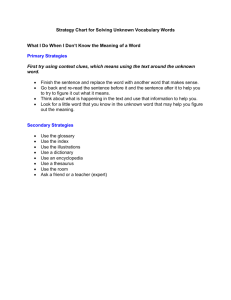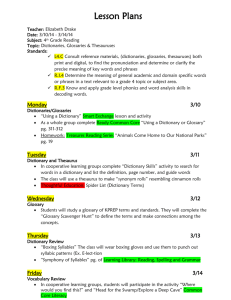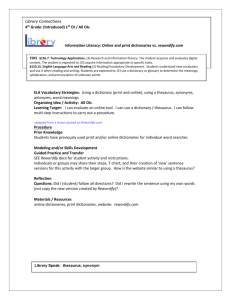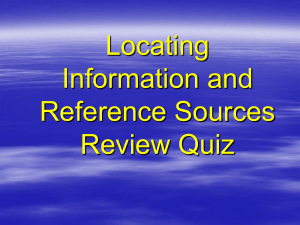Expanding Vocabulary Knowledge
advertisement
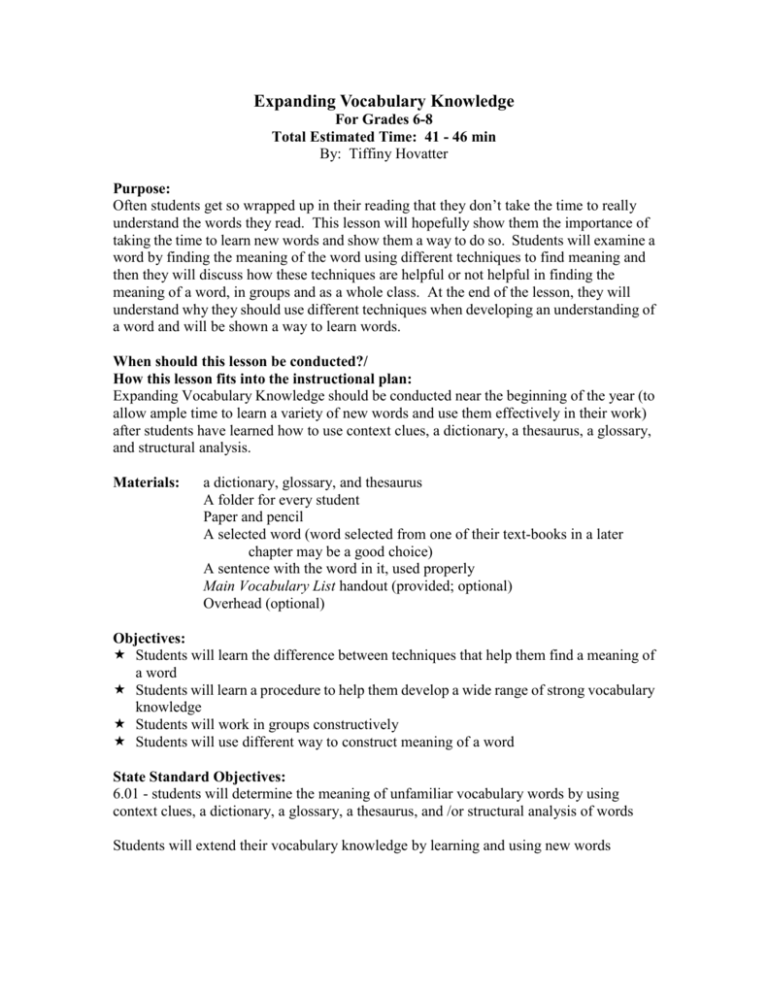
Expanding Vocabulary Knowledge For Grades 6-8 Total Estimated Time: 41 - 46 min By: Tiffiny Hovatter Purpose: Often students get so wrapped up in their reading that they don’t take the time to really understand the words they read. This lesson will hopefully show them the importance of taking the time to learn new words and show them a way to do so. Students will examine a word by finding the meaning of the word using different techniques to find meaning and then they will discuss how these techniques are helpful or not helpful in finding the meaning of a word, in groups and as a whole class. At the end of the lesson, they will understand why they should use different techniques when developing an understanding of a word and will be shown a way to learn words. When should this lesson be conducted?/ How this lesson fits into the instructional plan: Expanding Vocabulary Knowledge should be conducted near the beginning of the year (to allow ample time to learn a variety of new words and use them effectively in their work) after students have learned how to use context clues, a dictionary, a thesaurus, a glossary, and structural analysis. Materials: a dictionary, glossary, and thesaurus A folder for every student Paper and pencil A selected word (word selected from one of their text-books in a later chapter may be a good choice) A sentence with the word in it, used properly Main Vocabulary List handout (provided; optional) Overhead (optional) Objectives: Students will learn the difference between techniques that help them find a meaning of a word Students will learn a procedure to help them develop a wide range of strong vocabulary knowledge Students will work in groups constructively Students will use different way to construct meaning of a word State Standard Objectives: 6.01 - students will determine the meaning of unfamiliar vocabulary words by using context clues, a dictionary, a glossary, a thesaurus, and /or structural analysis of words Students will extend their vocabulary knowledge by learning and using new words National Standard Objectives: Standard 12: Students will use spoken language to accomplish the purpose to exchange information Standard 4: students will adjust their use of spoken and written language to communicate effectively with audiences Previous concepts needed: How to use context clues, a dictionary, a glossary, a thesaurus, and structural analysis of words. Instructions: Introduction - According to the North Carolina Standard Course of Study, you guys need to be learning new vocabulary words and using them in your writing. Understanding a wide range of vocabulary will help you also create better writing. So today we are going to explore the different ways to determine meaning of a word and find out why it would be important for us to use different ways. We have already learned how to use a dictionary, glossary, thesaurus, context clues, and structural analysis to find the meaning of a word, so today we will use these skills to explore the meaning of a word I will give you and then you will discuss what you have found in groups and discuss the differences between them. We will then come back as a group and share with the class our findings. Finally I am going to explain to you how I want you to continue learning new words, so that you will grow to have a wide selection of available words to use in your writing. Estimated time: 2 min Step 1: Remind students about the ways in which a person can find a meaning of a word. Write them on the board or overhead (if preferred) Using a dictionary Using a glossary Using a thesaurus Using context clues Structural analysis Step 2: Ask for volunteers to explain the strategies. Step 3: ` If all is agreeable, including yourself (the teacher), then write a summary of the explanation on the board under the appropriate heading. Step 4: When all five ways have been identified and explained, move on to step 5. Estimated time: 5-10 min Step 5: Give the students a word that you are sure no one in the class knows and have a ready made sentence that includes the word. If you are unsure about a word, bring a couple of words to class and go through your list until no one knows what the word means. Also words selected should be words that the students would be able to use in their vocabulary. As an example I will be using the word felicity and the sentence “She was the picture of felicity.” Step 6: Have each student on a piece of paper write down the word and then underneath the word write context and then what they think it means according to the context. Example Felicity Context- happiness And then have them write underneath their contextual meaning (with appropriate distance between them), dictionary, thesaurus, glossary, and structural analysis. **You could also provide them with an already made handout for this activity. I have provided you with one titled What Does This Word Mean According to…..? (It is alright if the sentence you give them does not give them enough information about the meaning of the word, this is kind of the point. Sometimes the meaning of a word is not always adequately apparent in the context and students shouldn’t always rely on their guesses. Guessing the meaning of a word through context I feel does not give adequate information about the real meaning of a word. Using context clues only helps students understand the meaning in general, I believe.) Now, have them find the meaning of the selected word according to the different way to find meaning, and write the meaning underneath the appropriate technique. Obviously, they will not be able to find the meaning through structural analysis, but this is kind of the point of the lesson, as well. Estimated time: 7 min After everyone is finished have them get into groups and talk about what they learned. Have them select a note taker who will write down their answers to these questions, for a group discussion. How did each technique benefit their knowledge of the word, if it did? How did the dictionary, glossary, or thesaurus compare to the structural analysis or contextual meaning technique? Why might we want to use more than one technique when trying to figure out the meaning of an unknown word? Estimated time: 10 min After groups have had ample time to answer these questions amongst them, bring them back together as a whole to find out what the groups have learned, by asking groups to share their answers to the questions you asked them to think about. You do not have to have each group share their response to each question; go around the groups with the questions. Eventually the class should come to a conclusion that the more someone knows about a particular word the greater understanding they will have of that word…. Therefore, it is important for students to use a number of techniques when learning a new word. And therefore, you are going to give them directions on how you want them to expand their horizon of new words. Estimated time: 5 min Tell them from now on you want them to write down any word they come across in their reading that they either do not know or are unsure if they know and write the page number. This will be called their Main Vocabulary List. (Hand out the folders) Out of these words they should select five of them to study, and write these words on a separate sheet of paper titled Weekly Vocabulary List, with the date of the week. Each weekly vocabulary list should include a meaning from at least two techniques. One technique must be from the dictionary, glossary, or thesaurus. And sometime each week they should buddy up with a partner to give each other a vocabulary quiz. The list will be kept in a folder, with the students name on the front, and the folder will be kept in the Vocabulary Folder box. They should also try to incorporate their vocabulary lists into their writing. When they use a word from their list they should highlight it. But the word should not be highlighted on their published/final work. And finally make it known that they will not be graded on their vocabulary quizzes, but you will be keeping an eye out as to whether they are trying to learn new words or just pretending. Ask them to write vocabulary on the folder and then write their name underneath it. Estimated time: 10 min Ask if there are any questions Estimated time: 2 min **This really isn’t all that difficult to keep up with. Students will have one folder they will keep all their vocabulary sheets in. When they write they can keep their Main Vocabulary list near them to use when trying to think of a word to use, one of these words may come in handy. And any time during the week they can take their vocabulary test with a partner. All you have to do is randomly select folders to check and see if they are doing the work. You could also randomly select works in progress to see if they are using new words. Additional Resources These websites contain vocabulary/word games or activities for students SuperKids http://superkids.com/aweb/tools/words/ Contain lots of vocabulary games Shepherd Software http://www.sheppardsoftware.com/web_games_vocab.htm Contains an activity to help students improve their context clues skills Vocabulary Games http://www.kn.pacbell.com/wired/fil/pages/listvocabulamr6.html Contains links to other websites that contain vocabulary games Vocabulary Games http://www.gamequarium.com/evocabulary.html Contains lots of vocabulary games
